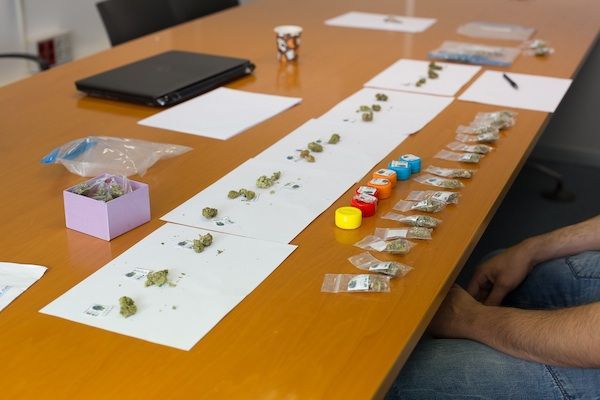- Twenty anonymous varieties laid out on the table, a well-cleaned bong, bottles of water to refresh the judges’ throat, and lots of control over the sensations provided by each puff.
- We attended the strain tasting at the III Cannabis Cup Expogrow 2014 (awarded on Sunday 14 September) with the smoke gladiators of Dinafem.
- It is a tough job, but somebody has to do it.

The first surprising thing about entering the tasting room is the extreme order of everything involved in the sampling, especially the preponderance of the twenty strains sent by the organisation to the different judges at this III Cannabis Cup Expogrow. This is the first time that The Cup has turned participants into judges; they will be the ones to carry out the blind testing and the rating of the different seed banks−except their own.
For every category (Best Sativa or Indica), 1-gram buds are analysed. Each of them is catalogued with an anonymous number and packed in individual little plastic bags. There are also awards for the best extraction (with and without solvent) and for the best auto-flowering strain.
However, what do judges usually take into consideration when deciding upon the best sample?

1- Visual Testing:
Touch, compactness, uniform colour…..there are many visual factors that influence the appearance of a champion bud. From the basic values−like being seed, plagues or fungus- free, to making sure it is fully covered in resin and has a perfect manicuring. Dry leaves can reveal a lot about how the sample has been grown.
In order to analyse all of the visual factors, judges use magnifying glasses as well as high resolution photographs taken for the occasion to zoom in on the herb's deepest crannies. They really look out for those little male flowers which sometimes show up, known as "bananas" because of their distinctive shape and colour.
Here you will find some photographs of some of the varieties participating in the best extraction category (with and without solvent) which are in a class of their own in terms of visual analysis.


2- Smell testing:
Smell is the touchstone determining if the initial appearance of the bud makes it a candidate to overall victory. Nevertheless, the judge's individual perceptions and tastes is what makes the difference here− and everyone to his own taste. But there are some general guidelines. For example, there must be harmony between what is seen and then tasted; so smell must be the link to achieve this, having a consistent, strong and intense aroma…
However, samples must also differentiate themselves from their competitors in the nuances, in the presence of different terpenes, in a smell that is divided into different parts during manicuring. This is why judges open the bag, move the sample around repeatedly, squeeze it a bit…They even smell it again once it has been passed through the grinder, in order to obtain the fullest range of possible smell sensations. This is the moment when the final smell rating is given, before the contents are thrown into a grinder for their subsequent combustion.

3- Taste testing:
This is the crucial moment of the tasting. The grindings are put onto white paper to detect any possible contamination or particles which may hinder the puffs; the bong is loaded up (if it is the case) with the best cuttings and is lit. Next, the first puff is inhaled with an almost religious solemnity. If it is hashish what is being judged, a glass rod is used which has been previously heated up with a handheld blowtorch.

But each teacher has its own book, in this case to make the most out of the puffs: smoking and exhaling through the mouth, nose, through both respiratory tracts at once, holding in the smoke for an endless number of seconds….anything the expert deems necessary to obtain the most complete taste sensations and effects.
If a sample is very potent then it must be noted down, as well as the distinctive throat clearing of heavily fertilised crops, which really sting. The colour of the smoke must also be noted down, as well as its density and presence. Even the ash in taken into consideration as it can provide lots of clues about the life of the plant. The combustion process itself is also observed: it should not give off many little sparks, and should burn evenly…
Then silence descends, and each judge notes down their taste rating, which will be added to the two previous figures (appearance and smell) in order to obtain the final rate of the variety being judged. This process is repeated for the rest of the participating entries. We will leave you with a video which attempts to summarise the process for both grass and hashish extractions. Bon appétit and may the best sample win!



Comments from our readers
There are no comments yet. Would you like to be the first?
Leave a comment!Did you like this post?
Your opinion about our seeds is very important to us and can help other users a lot (your email address won't be made public).